|
FAQs on Identification of Stinging-Celled
Animals
19
Related Articles: Cnidarians, Water Flow, How Much
is Enough,
Related FAQs: Cnidarian IDs 1, Cnidarian IDs 2, Cnidarian IDs 3,
Cnidarians ID 4,
Cnidarians ID 5,
Cnidarians ID
6, Cnidarian ID 7, Cnidarian ID 8, Cnidarian ID 9, Cnidarian ID 10,
Cnidarian ID 11,
Cnidarian ID 12, Cnidarian ID 13, Cnidarian ID
14, Cnidarian ID
15, Cnidarian ID
16, Cnidarian ID 17, Cnidarian ID 18, Cnidarian ID 20, Cnidarian ID 21, Cnidarian ID 22, Cnidarian ID 23, Cnidarian ID 24, Cnidarian ID 26, Cnidarian ID 27, Cnidarian ID 28,
Cnidarian ID 28,
Cnidarian
ID 29,
Cnidarian ID 30,
Cnidarian ID 31,
& Anemone ID 1, Aiptasia
ID 1, Stony Coral ID
1, Mushroom Identification,
Soft Coral ID, Alcyoniid ID, Xeniid ID,
|
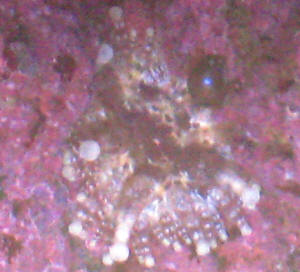
|
|
Pests or friends 8/17/09
Hello,
<Hi>
I love your website and have used it to troubleshoot my fish
tanks without asking questions for years! Far better than
purchasing a book when I can use first hand experience. Anyhow, I
have reached my first question and hope
you can help. I have attached a picture of something growing in a
carpet-like manner over my live rock, glass, and live sand. I
have read a ton about aiptasia pests and thought that this might
be one. However, I was looking in a Petsolutions magazine and saw
something similar for purchase as pre colonized green polyp Fiji
live rock. I did some research and have read that some vendors
sell aiptasia as colonized live rock not knowing that it is
really a pest.
<I'm afraid, it is not that they don't know what they
are, but that the customers don't know what they are.>
I purchased my first 55 gallon saltwater a little over a year
ago. This little creature was already growing in the system that
had been established for 4 years prior to my purchasing it.
However, they weren't growing as rapidly or as healthy
looking as they are now. I think that I may be maintaining the
water conditions better than the previous owner. If it is
aiptasia, I am going to purchase Berghia Nudibranchs. I have a
dense population of the green creatures, and if it is aiptasia it
will sustain a sizable family of Nudibranchs for a while. I am a
little concerned about ordering Nudibranchs because of the
potential for starvation after they have cleared my tank. I live
in an area where saltwater fish stores are an hour or more
away.
<Mmm, I am not thinking Aiptasia here. It is a little hard to
tell, but based on the lack of density between them, and the
colors, I am going to guess they are some sort of pest anemone,
do some searching on majano anemones and see if anything looks
similar.>
The guts of my question, what is pictured?
<As above, however the little buggers are obviously
"pests" in that they do seem to reproduce rapidly and
overtake your liverock making it a nuisance that you may want to
eradicate before it gets any worse.
Josh Solomon.>
|
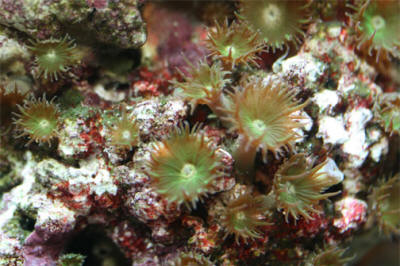 A Zo? RMF A Zo? RMF |
New Growth in Tank: Likely Hydrozoans 7/24/2009
Hello.
<Hi LaShaunda>
I noticed today that I have very small, clear, polyp or baby anemone
like solitary growth in several areas on the glass and on the live
rock. I am wondering what it is.
<OK>
I have some red algae on the rock and a small amount on the glass.
About a month ago, my well thriving purple tip Condylactis anemone died
within a few hours, which was very strange to me. I am just wondering
what this new
growth is. It is clear, has a tubular body, and it looks to have about
6 or so hair-like tentacles around its circular tip.
<Sounds like hydrozoans.>
Very tiny right now. Would you by chance know what I may have going on?
I 'm afraid that if I scrape the class I may be getting rid of
something good. Please help.
<Have a look on this page - http://www.wetwebmedia.com/hyzoidf3.htm
and see if anything looks familiar. If they are hydrozoans, I would
remove them.>
*LaShaunda*
<MikeV>
|
Polyps --IDs, aiptasia and zoanthids
07/23/09
I have had a saltwater tank now for about 2 months, one that a
friend gave me. The rock that was in it was not live rock. I have
been adding live rock to it since I have had it. All the non live
rock is out. Earlier this week I got some live rock from someone
that is taking down their tank. The one piece had 2 different
kinds of polyps on it and have come back to life since being put
in my tank where they have light now. I would like to know what
kind they are so I can look them up. I have just regular lighting
on my tank so hoping they will continue to survive in my tank. I
have attached 2 pictures: one of the 2 polyps,
<On the left you have what looks like bleached/ing zoanthids.
On the right, this looks like a type of leather coral.>
and 1 of what I was told is called a feather duster. After doing
some research it sounds like they are Aiptasia Anemones.
<Indeed. It is an aiptasia, not a feather duster.>
Are these anemones and feather dusters the same thing?
<Not at all. Please see here:
http://www.wetwebmedia.com/marine/inverts/cnidaria/anthozoa/aiptasia/aiptasia.htm
>
I want to make sure I am receiving the correct information as to
what I have in my tank. Thank you in advance for your information
you provide to me.
Julie Riha
<De nada,
Sara M.>
|
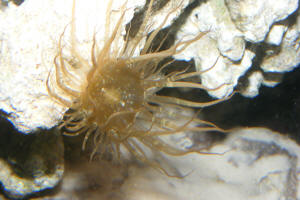 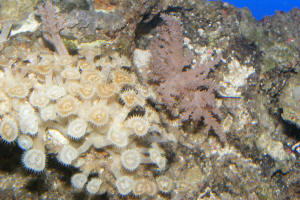 |
|
Really need your help. Majano, baby flower coral, cup
coral?? what is it? 6/28/09
Hello WWM team!!!
I have uploaded 2 pictures of this creature on the rock. I'm
surprised they even turned up on my camera. The tentacles are
pretty much clear. They appear to have tiny whitish bulbs on the
end of the tentacles. Not big bulbs. I had to study with a
magnifying glass. I've been told its Majano anemone, baby
flower coral, and possibly a baby cup coral.
<Does the skeleton go with it that appears to be below? If so,
neither of the anemones... Possibly the Scleractinian... Could be
a Rhizangiid, or single-polyp Euphylliid/Caryophylliid as
well>
Some are saying kill it and others are saying don't kill it.
It's in my quarantine tank right now and I wish to add the
rocks to my display tank. Please send me your thoughts.
<See WWM re the tentative IDs above>
Thank you so much it's greatly appreciated. I included the
pictures so others could see it when you post my question also.
May help someone else at some point.
Thank you so very much for your hard work and dedication to the
hobby :)
Korrine
<Certainly welcome. BobF>
|
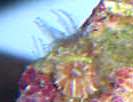 |
|
Interesting Hitchhiker: Pseudocorynactis --
6/14/09
Dear WWM crew,
<Hello>
I have a brand new to-be reef tank, 50 gals with 15 gal sump,
skimmer, small DSB in sump, live sand and live rock in display
tank.
<Nice>
The rock came from various local fish stores and is all
apparently Fiji rock. Some was more "dead" than
others.
<You'd be surprised what can pop out of what appears to be
barren rock after it's been in your tank for a while!>
The rock with the most life on it is really blossoming out.
<Neat!>
My parameters are pretty stable now at 1.0025 SG, pH 8.2 or 8.3,
KH 9, Ca ~450, temp 79 deg F (I live in the Calif. valley, so
it's difficult to get lower than this without going to
lengths). The live rock has several worms, maybe Spionids (2
palps); there are 2 sizes of those and one is quite scarily
large.
<It could be a similar little tube dwelling worm/Polychaete
called a Chaetopterid (family: Chaetopteridae). They have two
feeding appendages, a ringed parchment-like tube and can be
surprisingly large.>
There are also some small (really, really small) things that look
like
hydroids, but they are single stranded and perhaps only 3mm
long.
<Hmmm, do they live in a tube? If so, do they look like
what's in the following link?
http://bb.wetwebmedia.com/gallery/pic.php?mode=large&pic_id=307
If so, they're harmless Vermetid Gastropods. This common
hitchhiker reaches about 10mm or so in length and lives in hard
tubes that can break and be very sharp, so watch out. They feed
by means of casting out a single mucous thread that catches
particulate matter in the water and is then reeled back into the
mouth. If this is not what you have and you'd like to pursue
an ID, do try to get a photo or two and we'll see if we
can't get you some answers.>
There are 2 nice Sabella sp. type feather dusters and one really
tiny feather duster that I don't know.
<Many varieties>
There is one polyp that is almost certainly the dreaded Aiptasia;
see attached, 1st rather blurry picture.
<Yep, looks like Aiptasia.>
The second picture is an unknown polyp. It's pretty!
<Yes, indeed!>
Very small as well, perhaps 0.5 cm in total diameter, all splayed
out. I wondered if you could possibly try to identify it for
me?
<I sure can! It looks like a beautiful little
Corallimorpharian in the genus Pseudocorynactis. They're
harmless and usually nocturnal. Not a whole lot is known about
their care, but they're thought to feed on zooplankton/pods
and such. For more information/photos, please Google our site,
and the net, using "Pseudocorynactis':
http://www.wetwebmedia.com/Googlesearch.htm >
I used a tripod and remote shutter trigger, but it's still a
bit out of focus.
<Looks great to me!>
I have read WWM's FAQs on getting rid of Aiptasia and am
still confused. Should I try a peppermint shrimp initially since
I don't have enough food to sustain Berghia Nudibranchs and
it's too small to inject (at least for my skills)?
<I'd skip the peppermint shrimp since they come with their
own set of issues and go with a Kalkwasser (pickling lime) and
water slurry. This method works well on those small, nearly
impossible to inject anemones. Just mix Kalk powder with water
(to about the consistency of heavy cream), put it in a plastic
syringe (doesn't have to be one with a needle), turn off all
the pumps, and aim for the mouth of the anemone. As soon as you
touch it, it's going to withdraw into the rock. Chase it as
far as you can go with the syringe tip and inject the Kalk
solution. The idea is to fill and cover the hole with a small
blob of Kalk. You don't need a big mound covering the hole,
just enough to block the anemone completely. The reason you
don't want to go overboard with Kalk is that it's very
caustic and will burn whatever it touches (be sure to avoid skin
contact). It's a good idea to have a turkey baster handy,
just in case you need to remove any excess from within the tank.
Once you've covered the Aiptasia, wait about 5-10 minutes
then turn the pumps back on. That should do it, but if not, treat
again.>
Thanks much!
<You're very welcome! Take care, LynnZ>
|
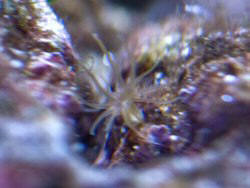 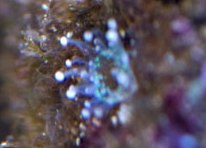 |
|
Anemone ID... Possibly a Pseudocorynactis sp.
06/05/2009
Hi
<Hello Dan, Mich with you.>
I need some help in identifying this Anemone hitchhiker. I have
spent hours searching through you site and others, but I have not
had much luck. Can you please help me in identifying it?
<I hope.>
Here are some helpful observations: It is about the size of a
quarter in diameter with white and reddish/brown coloration, and
it seems to be nocturnal hiding in rock crevasses during
daylight.
<This is most interesting and makes me think it might not an
anemone at all.>
I have also attached the best picture I was able to take.
<Not the best, but all is helpful. I suspect you might have a
Pseudocorynactis sp. which would be desirable.>
Hopefully its size is acceptable,
<Yes, size used to be an issue with our old system. Not so
much anymore.>
if not please let me know and sorry.
<No worries.>
Thank you in advance for any information you can supply me with
and also thank you for such a helpful website, keep up the great
work.
<On behalf of Bob and the crew past and present, we thank you
for these kind words. Mich>
-Dan
|
 Good call Mich. RMF Good call Mich. RMF |
|
|

